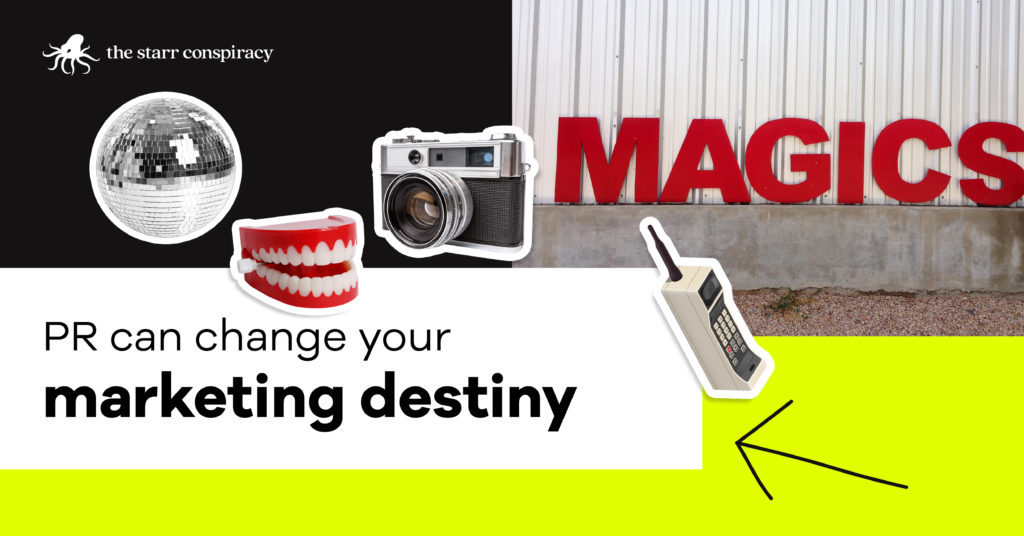… and how PR can change your marketing destiny.
What I’m about to say is going to piss off a lot of my public relations colleagues. Most PR leaders and professionals can’t explain the value of earned media.
When the C-suite or marketing owners ask PR to explain the ROI of their work, you’ll see charts about impressions, share of voice (SOV), or sentiment — all explanations of PR that seem to only matter to PR people. They cannot make a business case for spending on PR — whether it’s an internal department or outside agency spend. Why? Because they lack the right data points or are unable to connect the dots to the bottom line.
PR folks will tell you that what they do is different from marketing and that their impact is about changing opinions, not feeding the marketing funnel.
Now, I’ll agree that PR can shift attitudes, behaviors, and beliefs about a brand over time with the right positive coverage or thought leadership. And that might really matter in the B2C world where public opinion, brand loyalty, and reputation reign supreme for many consumer products. But everything is about leads and revenue growth in the B2B world.
Here’s the rub. PR content (typically) lacks trackable links used in the marketing world to attribute its efforts to prospect touch points in the marketing/sales pipeline. So that’s when PR people shrink and say “PR is different from marketing.”
Here’s where I disagree. B2B buyers, you know, just regular humans, wake up in the morning and consume information. They don’t distinguish between paid, owned, earned, or shared media. They just consume information. Maybe they download a white paper, skim an email newsletter, or read about a brand in a press story. Maybe a person doesn’t distinguish between the source. I might argue that people put more faith in PR content because it gets printed, aired, or hosted on a known publication or channel.
Either way, the information impacts their aided or unaided brand recall or plants a functional association (what a brand offers) in the recesses of their mind. Marketing will tell you that educating that buyer with content is part of the buyer’s journey — the awareness, research, or active evaluation phases of the marketing/sales pipeline.
It takes significant touch points (impressions) before a B2B buyer engages with sales. Research by Forrester suggests that buyer interactions (touch points with a brand) jumped from 17 in 2019 to 27 in 2021. The research firm included buyers’ own research from multiple sources, including the internet, trade and mainstream publications, and word-of-mouth conversations.
Pause for a moment. Note that B2B buyers are consuming information on their own long before a brand tries to send them content, which includes PR. Ding, ding, ding!!! That means PR impressions are a part of the buyer’s journey. Marketing often invests in brand awareness activities to become top of mind with target buyers and make their lead-gen activities more efficient (lower cost per lead, short-listing for RFPs, velocity in the pipeline, etc.). PR can get you those impressions for free. Turns out PR is much more than just shaping an opinion about a brand. PR is one of the touch points in the B2B buyer’s journey. So measure THAT.
What we recommend you measure when it comes to PR:
Impressions: In the world of PR, this is a potential audience reach for a press piece that normally would require marketing to spend money to reach via advertising, syndicated content, or other digital means. Don’t measure these solely for the sake of growth (though that should matter too). Understand the correlation or share of impressions in a brand’s overall paid/owned/earned media strategy and performance.
Share of Voice (SOV): This is measured in comparison to key competitors to know how much of the conversation a brand is dominating. Consider this a proxy for brand awareness via earned media channels.
Keyword SOV: This is a nuanced exercise that should focus on unique keywords. In most cases, these keywords are NOT solution category labels or SEO words that your competition is also likely using. The words to zero in on are tied to polarizing messaging, your brand’s unique POV, differentiating approach, or what matters most to your radical buyer (a buyer that is radically aligned with your brand along attitudes, behaviors, and beliefs).
Keyword search: What keywords and topics are being targeted to find your brand? When prospects are looking to solve a problem, what terms are they using to discover your solution or product?
Website traffic: Here’s where you can uplevel your PR game. Show the correlation between PR impressions and campaign and changes in inbound traffic to your brand’s website. Just as marketing brand awareness activities lead to increased interest, so does PR activity. Own this.
Backlinks: Show the correlation between earned media wins and the change in website domains linking to your brand. PR wins not only bring traffic to your website, they can also impact your own site’s domain authority. (Think what a Forbes or Fast Company win might do to your strength with search algorithms.)
We have a very marketing-focused view of PR, and maybe that could help a lot of PR leaders and professionals rethink how they measure and report on their work. We think PR has a profound impact on brand awareness. A healthy investment in brand makes marketing’s job easier. There’s your proof. Now start measuring what matters to people with budgets.
We’d love to have a conversation with you about how to level up your PR.


